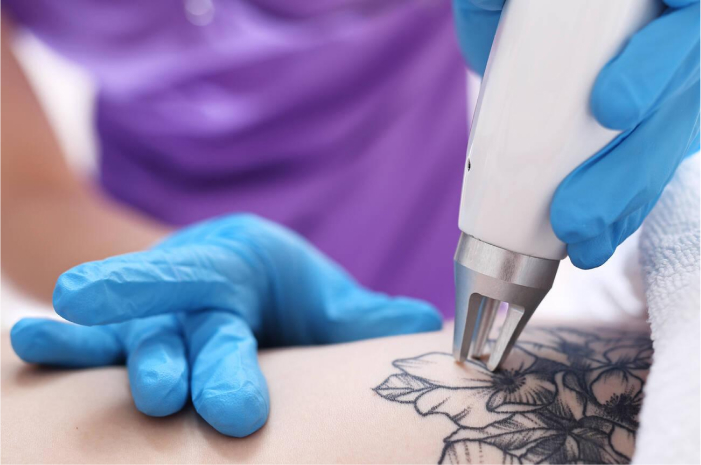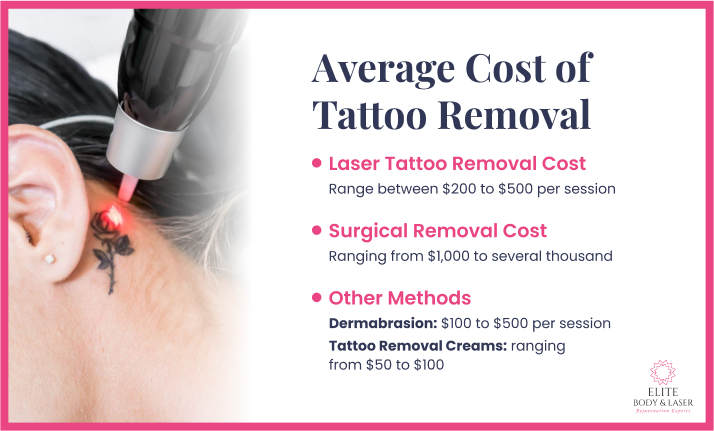Getting a tattoo can be a thrilling experience, but sometimes, the excitement fades, leaving you pondering over the cost of removing an unwanted tattoo.
The straightforward answer is that tattoo removal costs vary widely, ranging from a few hundred to several thousand dollars.
However, this is just the tip of the iceberg; the real story behind the costs of cosmetic procedures is far more nuanced and deserves a closer look.
Read on to know how many sessions, the cost, and if a tattoo removal is worth it.

Factors Influencing Tattoo Removal Cost
Several factors come into play that can significantly impact the overall cost of removing a tattoo.
Therefore, understanding these variables is crucial for anyone considering tattoo removal near me:
Size and Complexity of the Tattoo
- Size: Generally, the larger the tattoo, the higher the removal cost since larger tattoos require more time and resources.
- Complexity: Detailed and intricate designs often mean more work for the removal process. This means complex tattoos with multiple colors or shading can increase costs compared to simpler, monochromatic designs.
Number of Sessions Required
- Tattoo Age and Ink Depth: In some cases, fewer treatments may be needed, especially for large tattoos or those with black ink, which can sometimes be easier to completely remove.
- Ink Color: Certain ink colors are more challenging to remove (like blues and greens) and may need additional sessions.
Type of Tattoo Removal Procedure
Laser tattoo removal is often more cost-effective for larger or more complex tattoos, while surgical removal might be preferable for small, simple tattoos.
Dermabrasion can be a middle-ground option, but its effectiveness varies.
Laser Tattoo Removal
This is the most common and effective method. Laser tattoo removal uses concentrated light beams to break down the ink particles in the skin.
Costs can vary based on the technology used and the clinic’s location.
Surgical Removal
This method involves physically cutting out the tattooed skin and is generally used for smaller tattoos. It can be more expensive due to the surgical procedure involved.
Dermabrasion
This technique sands down the skin to remove the upper layers where the tattoo ink resides. Dermabrasion is less common and effective for certain ink types or skin tones.

Average Cost of Tattoo Removal
Laser Tattoo Removal Cost
Average Price Range Per Removal Sessions
Laser treatments typically range between $200 to $500 per session. Nevertheless, the total cost depends on the number of sessions needed, which varies per case.
Cost-Increasing Factors
Larger, more colorful, and more complex tattoos often require more sessions, increasing the overall cost.
Advanced laser technologies also add to the expense, though they often offer more effective results.
Surgical Removal Cost
A tattoo surgical excision is generally more expensive, potentially ranging from $1,000 to several thousand dollars, depending on the tattoo’s size and location.
Surgery is usually reserved for smaller tattoos or when laser removal is not viable –– it’s a more invasive procedure but can be effective for complete removal in a single session.
Other Methods (Dermabrasion and Creams)
While dermabrasion and creams are less costly, they often need to provide results that are more effective and reliable than laser or surgical methods.
- Dermabrasion: This method can cost anywhere from $100 to $500 per session. Its effectiveness varies, and it may require multiple sessions.
- Tattoo Removal Creams: These are often the least expensive option, with prices ranging from $50 to $100 for a course of treatment. However, their effectiveness is highly debated, and professionals generally do not recommend them.
Additional Costs to Consider
While the primary focus is often on the procedure’s cost, additional expenses can influence your budget for tattoo removal in Ohio.
Let’s explore these often-overlooked aspects.
Consultation Fees
Consultation fees can range from free to around $100, depending on the clinic and the complexity of the tattoo.
An initial consultation is crucial for assessing your tattoo and devising an appropriate removal plan.
It’s also the perfect opportunity to ask questions and understand the process better.
Aftercare Expenses
- Healing Ointments and Creams: Essential for post-treatment care, these can cost between $10 to $50, depending on the product.
- Bandages and Dressings: Necessary for protecting the treated area, these supplies might add $5 to $20 to your budget.
- Pain Management: Over-the-counter pain relief medications, if needed, can cost around $5 to $15.
Travel and Time Costs
- Travel Expenses: If your chosen clinic isn’t nearby, consider the cost of transportation or even accommodation for multiple sessions.
- Time Off Work: Depending on the nature of your job and the intensity of the treatment, you might need to take time off, which could have financial implications.

Things to Know About Laser Tattoo Removal
Understanding how laser tattoo removal works can help demystify the process and set realistic expectations for those looking to fade or completely remove an unwanted tattoo.
- Principle of Laser Removal: Laser tattoo removal utilizes specific wavelengths of light targeted at the tattoo ink. The tattoo ink particles absorb the laser’s intense energy, causing them to break down into smaller fragments.
- Impact on Different Ink Colors: Different ink colors respond differently to laser treatment. Black and darker skin colors absorb all laser wavelengths, making them easier to remove. Conversely, lighter colors like yellows and greens are more challenging and may require lasers with specific wavelengths.
- Session Duration and Number: The duration of each laser treatment session can vary depending on the tattoo’s size and complexity. Generally, sessions last from a few minutes to an hour. The number of sessions needed (how many sessions) depends on the tattoo’s age, size, color, skin type, and the desired level of removal.
- Advancements in Technology: Modern laser technologies have significantly improved the effectiveness of tattoo removal. Newer lasers, like Cutera, provide fewer treatments and better results, even for previously hard-to-remove ink colors or large tattoos.

Insurance and Financial Assistance
Does Insurance cover Tattoo Removal?
Typically, tattoo removal is considered a cosmetic procedure and is not covered by most health insurance plans.
However, there are exceptions, such as when removal is medically necessary (e.g., allergic reactions, infections).
Payment Plans and Financing Options
Many tattoo removal clinics, like Elite Body & Laser, offer their own payment plans, allowing you to spread the cost over time. These plans can vary greatly, so it’s important to understand the terms and interest rates involved.
There are also external financing options available, such as medical credit cards or personal loans.
Be sure to research and compare interest rates and fees thoroughly.
Wrapping Up
Understanding the final cost to remove older tattoos is crucial in making an informed decision about this significant journey.
If you’re ready to take the next step, have more questions, or are curious about more treatments, reach out to Elite Body & Laser –– a powerhouse of rejuvenation experts and professional tattoo removal specialists in Columbus, OH.

